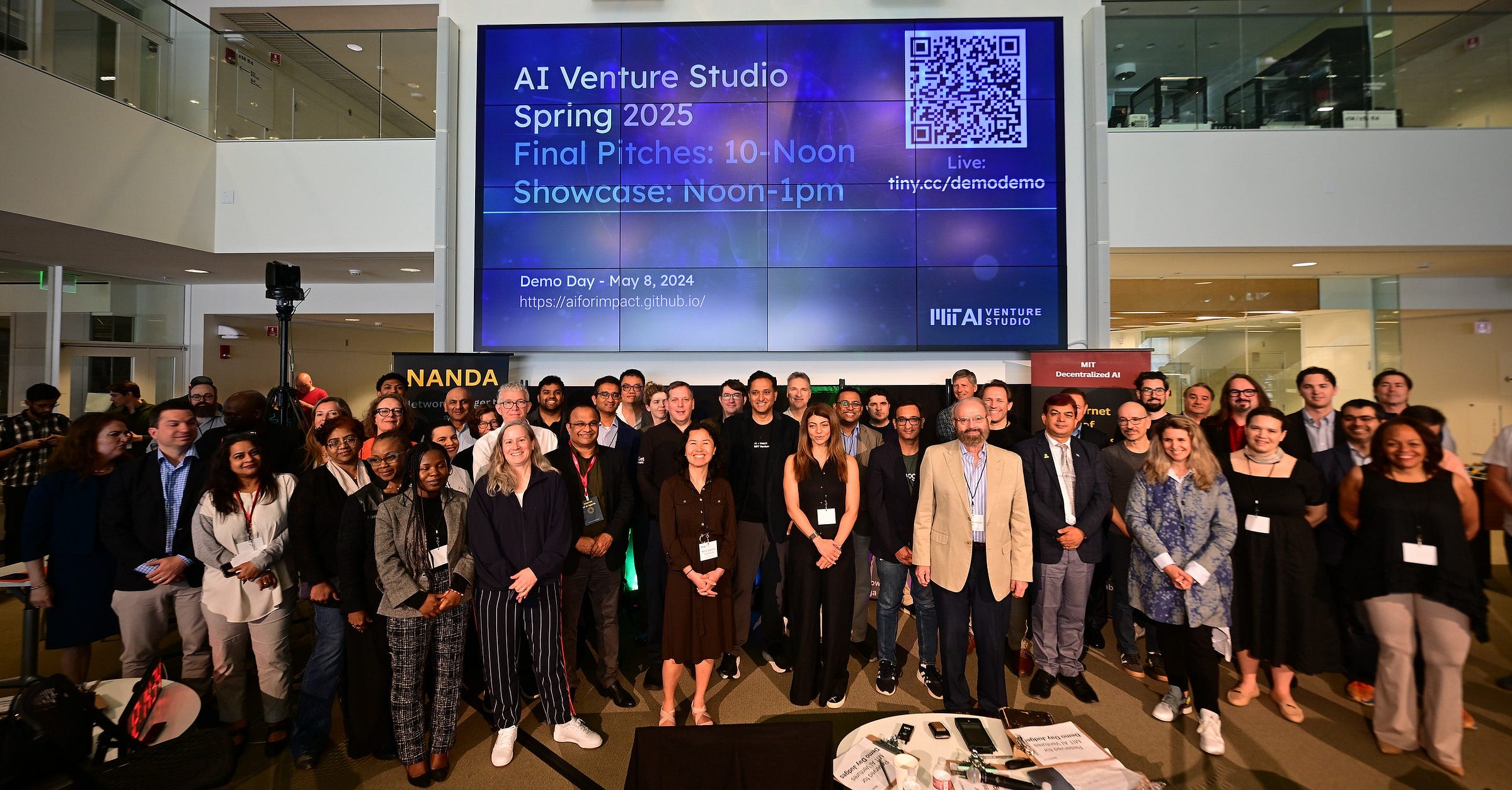
This post is part of a recurring series focused on Execution In the Arena: Project Leadership and Tactical Applications — the second pillar of the From Here to There game plan. How do you actually work with your people to move forward? Here, we discuss tactics, strategy, and specific aspects of the operational and functional core of reaching your destination.
How do you lead, build, and deliver when the pressure’s on? In this reflection, I share field notes and firsthand lessons from serving as a judge at the MIT AI Venture Studio Demo Day. With over 20 teams pitching AI-native products, this was more than a tech showcase — it was a masterclass in leadership, communication, and real-time decision-making.
What can founders, mentors, and teams learn from high-velocity demo events like this one? This recap dives into what worked (and didn’t), how top teams demonstrated value under pressure, and what made the winning pitch stand out — plus lessons for anyone guiding people toward meaningful execution in uncertain terrain.
The audio is revised, originally taking place in part during a discussion with Dr. Bradly Alicea during a recent Orthogonal Research and Education Lab meeting.
Discussion Transcript + Photos & Quotes
A summary post of my experiences and takeaways from MIT AI Venture [Studio] Demo Day. Originally I had a conversation with Dr. Bradley Alicea at one of the Orthogonal Research an Education Lab meetings meetings this month, but the audio wasn't really the best quality. I figured I'd just redo it a bit and summarize the key points here. So let's get started.
MIT AI Ventures Demo Day: Background
The event itself was called, AI for Impact on Society Scale Problems, a semester long course at MIT for graduate students. I believe it's housed in the Media Lab itself, proper. [The course,] it's run by Ramesh Raskar. But John Werner was the MCof the event and is involved with the course as well. It's a semester long course at the Media Lab and it's getting people acclimated to, creating your business, your product.
You make it AI native as opposed to a wrapper or some kind of trivial add-on. It's based around an AI service itself at the core. And of course there's a lot of leaning towards, agent AI and the future here. Sort of what a lot of this insight and focus of the course is about.
So you have mentoring in the course, you have development, you have ideas, and you had about six weeks to actually build things out. Now I really wonder — and I didn't get to ask all the groups about this when I was, meeting them as a judge, that was my role in the event. I didn't get to ask them, “so have you been working on this for much longer than the course or not?”
That familiar Progress vs Time Chart
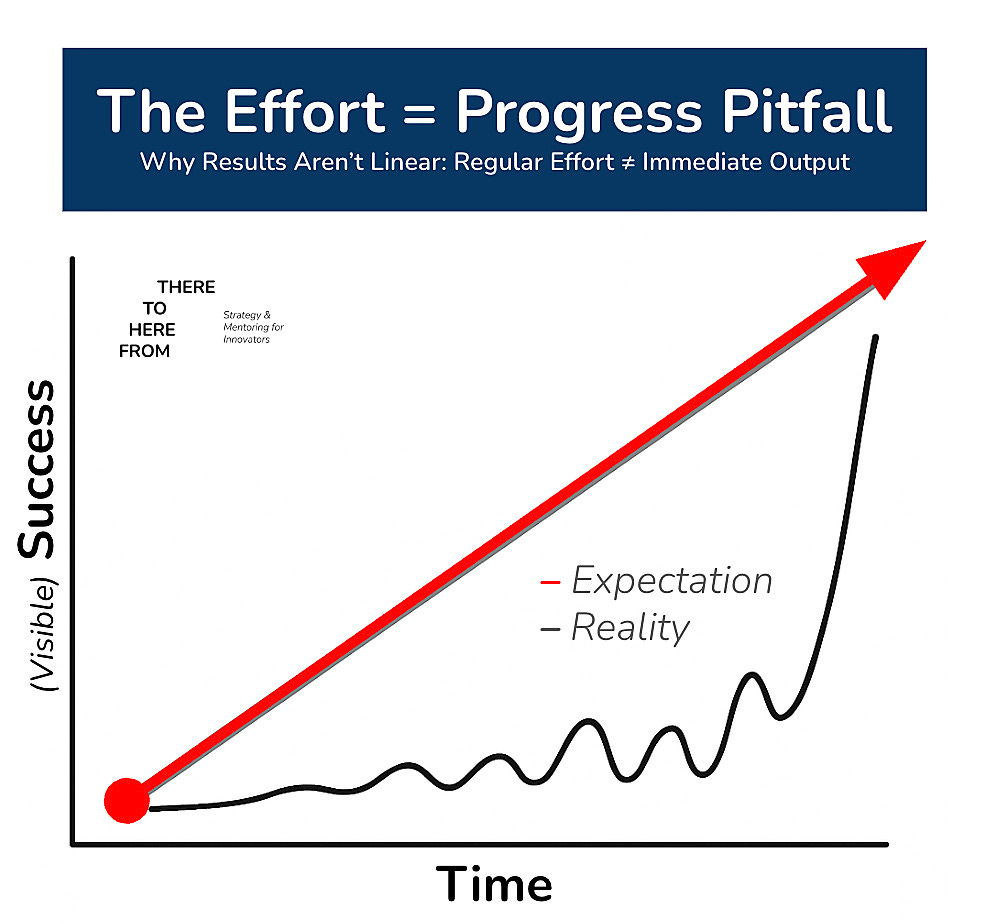
That's one of the key factors and something I've been mentioning recently in my discussions on progress versus momentum or iteration and stagnation. If you get started on the timeline sooner, the desired impact of the linear direct relationship between progress and time might look different than if you're just starting out. So more about that later.
For the demo day itself, that was May 8th, and you had judges and catalysts, you had the audience, and then you had, I forget, 20+ teams or so. Most of them having three minute pitches, some of them having one minute kind of additional small pitches.
The judges and catalysts comprised of many folks folks in industry for several years, several venture capitalists and people buying, selling companies, several investors. It was impressive to be part of that group. And, a great benefit to me, and I appreciate many of the networking opportunities that were intentionally crafted by John Warner, who we'll get to next,
Orientation & Criteria
What were we judging on? What was the actual criteria for the events? It wasn't just about making a bunch of money. the judging was scale towards the course theme of societal impact.
So the criteria were, number one impact, which was left kind of subjectively to decide what you wanna do. Like what would the actual impact be of this project?
Number two, uniqueness. How many people are doing the same kind of thing. What is that actually innovating? what is the newness that it's bringing to it?
And then third completion, how far along is the project?
Completion was particularly interesting because it was sort of the most objective, but also the most easy to tell based on the demo, or at least the greatest opportunity to actually convey something in the demo itself. Uniqueness is really about the rest of the industry and what the individual judge might have been exposed to already.
So it is a different dynamic, but it's interesting to put those three together. And of course, the scoring is the scoring. it was what it is. But there was a first place winner, who we'll talk a bit about later, and I actually got the chance to interact with them a little bit.
So the next section that I wanted to talk about for the event was Leading and Mentoring, and then we'll get into presenting specifically at these kind of events. Followed by bigger takeaways at the end.
On Leading & Mentoring: Managing Events and Training Your Teams for Success
It really was a masterclass by John Werner; and I've been to a few of his events before in terms of Imagination In Action here in Boston, he holds all kinds of things all the time. That's what he does. But for those who don't know, John Werner, he's with Link Ventures, a venture firm that he's very experienced with and has done many things with and has great, people on his team, who also helped out with this course. He's part of MIT Connection Science and a bunch of other things in all manner of the innovation, community here in Boston. and nationally and probably internationally. And he has a column with Forbes. So he's sort of a role model in that sense.

It was definitely a privilege to get a front row seat. How the event was put together, how the judges, the VIPs, the people that you're asking favors of to give time and give, give a damn about what's happening, how those folks were treated and prepped and oriented. And then —I wasn't part of how the teams are prepped—but kind of being able to extrapolate, here's how the judges are handled, here's how the event's being handled and here's how the teams are being handled.
It was a very interesting context to observe, and by far one of the biggest takeaways, which is being impressed with how fun the event was. From my end as a judge, I've done some judging; I've done [journal/submission] reviewing, I've done, high level events, and I've handed out medals to, like the Lego First (building things for the kids), and that's pretty fun. But I think this takes the cake for a high level professional, lots going on [category of] event.
The pacing, there was a constant, I almost wanna say rush, but it didn't feel hurried. It just felt like, okay, this train is moving - let's all move together.
Let's keep going on this path. Here's a few jokes, here's some well planted props and some planted stories and some wisdom. And I'm gonna loosely put together some dots that you can connect for much broader perspective. And I thought that was just amazingly well done.
“Know who’s in the room” - or who you can pull into the room
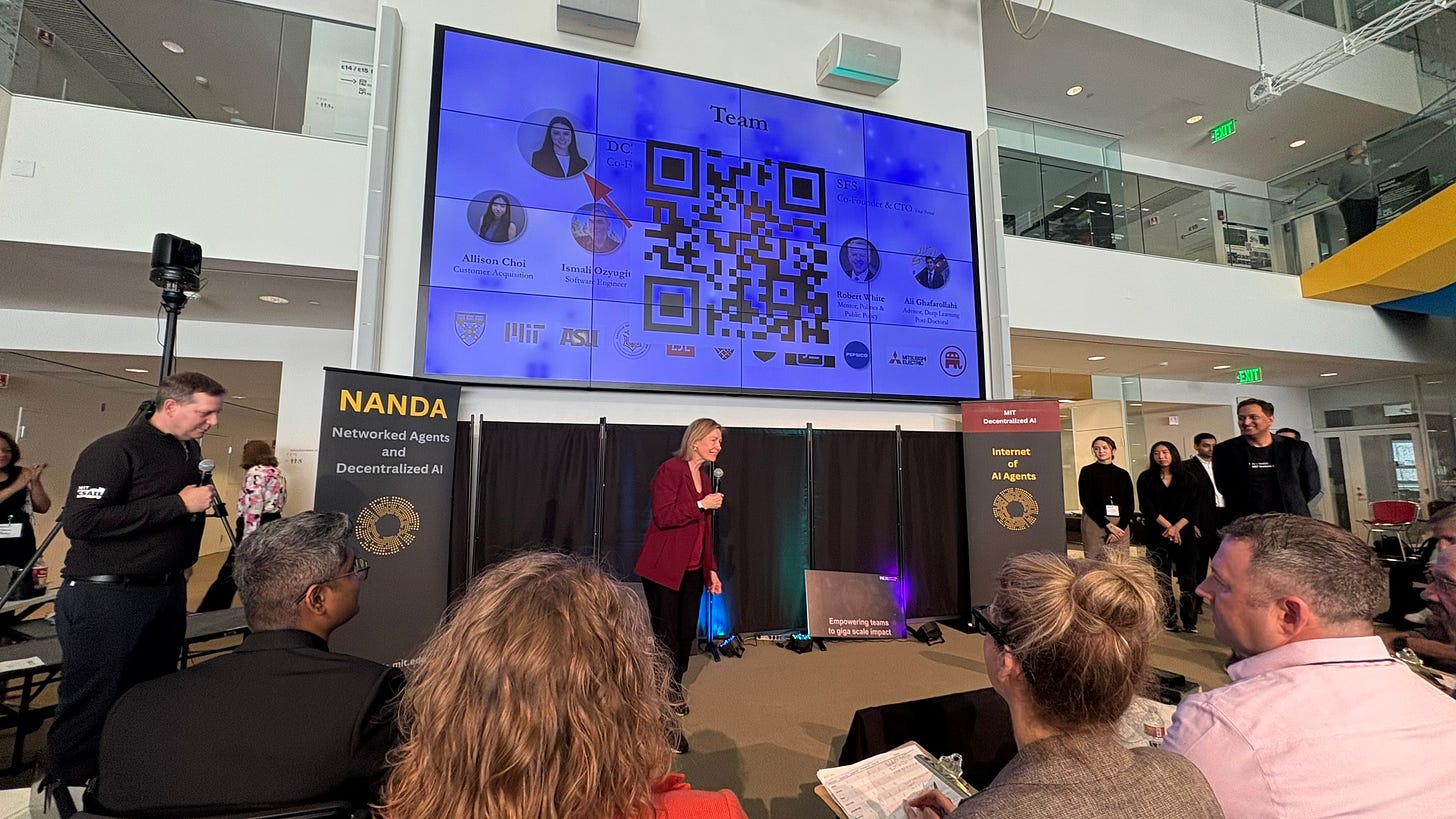
John would also, his this great mix between keeping the train rolling and then making these brief pit stops. He would call it, “Know who's in the room!” Or [one time], he pulled Rosalind Picard from MIT, like, oh, she's going to lunch, but hey, know who this person is. Like he would just pick people out. Not only because, hey, yeah, hype or clout. But also to instill into the students and to others there, (but probably mostly the students): here's ways to connect. Here's ways to find value. Here's ways to bring what it is you want to do to life, and here are people who can help you with that and be aware of who is here so that way you can engage them. I just thought that was very, very, very well done.
In the orientation session for the judges, he handed out, an Apple /Mac Newton, the sort of failed drawing pad, stylus and drawing pad that I think the technology failed and it was a big flop and caused some shakeup at Apple at the time. And Bradley had a nice, commentary on that in the in the lab.
He also had a MIT yearbook from decades past. And then a, a likeness of the, communicator, I think it was the communicator, not the Tricorder, but from Captain Kirk's Star Trek, the communication device. And he had a nice little, very simple story about, you know, it's been 250 years since, the country, the United States developed, 250 years from now, supposedly when Star Trek things are happening.
What's sort of the delta? Where are we in these processes? Let's think about the future. I'm sure the crowd and everybody there is super amenable to that and doesn't need a lot of handholding. So maybe that's why John also, correctly or aptly knew who he was talking to and didn't need to extrapolate all that stuff.
And it was more, okay, you guys get this. Let's go. But there was, through the whole process, there was a definite, instructions and, and leadership components for mentees, how you're training mentees.
Lessons: Demonstrating the Value of (and care for) People’s Time
One of the biggest themes from all this was that, time matters appreciating and showing people's time matters.
And how do you do that? How do you convey the meaning? How do you hit your key points? And save the rest for appendices or for follow up and really make those points clear. These kind of things were super important. John would offer quite a bit of support, especially for those that maybe needed a little boost or were doing this for the first time, or I think there may have been an undergraduate or two somewhere that actually participated in the course.
But also challenge challenge and intrigue when possible for the people that were more comfortable with things, John would kind of try to ruffle their feathers or say something like, “Oh, Harvard, a Harvard student, MIT student, are they gonna have a [conflict], are they gonna be able to work together?” Kind of playing up some generic rivalry thing and. It’s creating this sense of staying loose but staying moving. It was quite well done.
For the audience, a lot of what John was able to do was basically minimize downtime and really centered on keeping things fun, pointing out and creating value, and trying to “minimize value leaks”, which is a strange way to say it, but it's what It was, it really is really keeping the attention where it needed to be and then offering perspective when possible.
There would be a few comments when he would insert context or background, either about our presenter, about someone's personal experience, about who was stopping by. about some important figure in the room. or about some project or some success that someone had.
And I think it was just very well done in terms of keeping the audience — pointing out audience, here's what you should be looking at; mentees, here's what to expect here’s what you should be doing; judges and catalysts, here's what to expect, here's what's going on here. Here's how we're moving forward. And very clear for all three [groups] of them.
And as I say, it was always about valuing the time and the tension always about keeping things moving and then very select pit stops.
Lessons: On managing discussion, and centering what mattered
So you knew you, you'd [develop] this implicit trust. You knew if John was gonna stop and talk about something and interrupt the pretty regimented flow of three minutes for each team. It was gonna be important. It wasn't just John willy-nilly extrapolating at something. [It was this sort of passive] Inclination for you to feel, okay, something's happening here and things are moving fast, but I'm gonna continue to pay attention and I will emphasize John would kind of forcefully tear the mic away from people at times. Sometimes it was funny, sometimes they handled it well, a few people didn't handle it well.
But you knew it was coming. You knew the audience laughed a few times “okay, after the first presentation, let's cut somebody off.” John would very forcefully truncate questions and responses. And it was both for the sake of keeping things moving forward, but also communicating particularly to the teams and the mentees and the students that were learning.
It was a way of communicating: You've said the key point already. Don't waste your time here. Look to follow up. And keep going for what else you can do. And it was a way of really modeling for them, like how to make the most of your time. And also to respect the time from the VIP guests who are asking these questions.
The industry experts, the people have launched, the companies, the investors, the venture capitalists, the people who've done this before. So it was a very implicit... I wonder how much coaching, in the class, I'd love to talk to some of the students more in depth. Were you taught this in the class or is John just modeling this here for you?
How much of that that went on? Because I think that was fascinating to see. And it was very subtle. In some ways it was a very overt in other ways of the mic tearing away. But the lessons being presented have quite a bit of carry and will really prepare you for the situations that you need, [when] you need to do that.
But also it wasn't all just, Demo or Die hard stuff. Even though that top level pitching was there, there was reasonable sense of: use your appendices. Metaphorically or literally Use your follow up time. Make the point, make the connection, be ready to move on, 'cause you have to keep moving, but then come back to it later and know that you can go up and talk to this person. You can network directly, virtually, and you have their name. Have their contact, you can follow up with them, make the connection happen. Get the main point first. And I just thought that was very well done.
On Presenting: What Pitchers Did Well, or Not
So let's talk about the presenting for presenters. What do the presenters do? What do we take away from these people that were pitching at MIT ventures on the demo day
First, prepare. You gotta prepare. Prepare like crazy, all that stuff. Make your mistakes in the safe space, ideally first; and most of the presentations were very good, very skilled, very well rehearsed, and all that stuff.
And even the sort of, tone and approach are you being professional? Are you being a little cheeky? Are you conveying that you're ready to be bought and invested in or not? All those things took place, right?
And then anticipate the curve balls: in the spirit of keeping things moving, but also I think presenting a little bit of reality, John would not hype everyone up the same way. He would sometimes create totally untenable, unrealistic BS questions for someone to answer. Knowing the person (usually) could just deflect it if you like, “Thanks for that, John. We're gonna talk about what we wanna talk about”, but it was this atmosphere of it's okay for all of us to be jostled.
There was a healthy amount of be active, be on your feet, be alive, be loose. And get ready to handle, get ready for some weird punch— not too severe of a knockout blow— but some weird punch at your way that you're gonna deflect or play off of. And I just thought modeling that environment and that atmosphere was, very nice and most of the students, handled it well.
So being able to handle the curve balls, having your perfect three minute pitch, here's what you're gonna do, but then realizing, oh, you might have some just silly thing or technical failure or some interruption show up at the start. How do you handle that? How do you handle the the interruption?
How do you handle the, unexpected? And I think that's great implicit training that reflects a lot of your life situations. How do you adapt and still make your points hit your keys? And get out.
The next major point, which was critical. And I think one of the biggest differences between what made this pitch, a success or a winner or not here… what really applies super broadly whenever you're doing a demo or an elevator pitch (it's something that I'm not perfect at and was just a great set of experiences of seeing).
…Is how do you really concisely visualize or show the thought and care that you've put into things? Because you have to tell people, especially when you're pitching, especially on a resume interview, whatever it is, you have to show them. You have to make it explicit.
A Pitch Must: "Make it explicit" - digestibly demonstrate the work you put in, and the value it contains
I didn't write that on the board, but definitely hashtag Make it Explicit. You have to make something explicit. And you have to point very clearly to, “Hey, look at this. This conveys value. This conveys the hard work and the effort. This conveys the expertise. This conveys something.” And if you don't have it, it's very challenging for people to believe in it.
There has to be something there and the more clear and explicit and obvious it can be, the more you can find a way to convey what it is, the better some of the applicants. The presenters had very impressive demos that worked right away that you could either see. Some people pulled out their phone and spoke into it.
And if you don't have it, it's very challenging for people to believe in it. There has to be something there and the more clear and explicit and obvious it can be, the more you can find a way to convey what it is, the better…
If you don’t have it, you need to have it. And if you don't know how to show it — off, okay, then you're in trouble.
Some people did it, and that's still . But having something to point to that works really well and implicitly conveys the context or meaning or thought or effort. That's critical. If you don't have that, you need to have it. And if you don't know how to show it off — okay, then you're in trouble.
Because there will need to be something to direct the attention to. And I think that's one of the implicit lessons here all the time is what are you directing your attention to? And are you amplifying the attention and the visibility and the value, or are you diluting it?
And as I'm writing and saying all this stuff, it's oh man, there's this. Much deeper training that's happening in my brain now. And I'm starting to see these lenses and it's not gonna be perfect right now, but developing that, that lens and that literacy is, is so key.
And yeah, conveying the expertise as the next point. Like how do you convey expertise and this is a way you can do it, or in general, how do you convey the expertise of nice idea, but who is the subject matter expert that you're working with? Who knows this industry? What's your qualifications that what you're trying to do matters or will be functional in this space?
That's super important to point out also, and if you can put that in the visual or demonstrate it somehow, a lot of that time it was conveyed through, oh, here's our excellent panel of advisors that have years of experience, blah, blah, blah, blah. And that's one way to do it, but however you can — great.
Who you gonna sell to?
One of the most important questions on another topic. Is, who are you gonna sell to?
That was the most common question from the audience, from the VIPs from the judges, from the catalyst was, who are you gonna sell to? And it's an, it's a foundational question, and their question was the most common.
Not only because it's really important, but… Really directly saying in your pitch, at least in this case for this, AI Ventures demo day pitch, saying who in the pitch and saying a clearly or having a clear follow-up response to the question should be handled with care. If you can't do that that's a challenge that's a definite, that's something that must be handled directly. And if you don't have an answer for it, it's bad. You're gonna have to know that kind of a thing. And if you aren't thinking about critical questions like that and you can't present them right away, then that will indicate what it is that you need to work on.
So who are you gonna sell to? What is the market? And then of course, the big question here, this sort of future oriented GenAI, era. Will that market exist in five years? Where is it going to be? Have you done the due diligence of talking with blank, blank, blank? Have you talked to people in the field?
Some of the better presentations were very explicit. Oh, we have talked with this group. We have, this number of people sign up already. We're already working on a pilot with these organizations or these leaders in this space. That is very powerful to. Both build out your product, but then also to convey to other people that you're taking it as seriously as you can.
Don’t forget: say the keys, make the exit
And then once again, to conclude this section the key methodological approach to everything is hit your key points, make your set piece, and then don't chase the details too long. Make the exit, let the questions come, and let the follow ups come. So know what you wanna say.
Make it very clear, make it explicit. And then don't belabor the point.
It depends a bit on the time that you have in the audience that you have. But when you're making your impression and you're doing the pitch, you have to make the pitch very strongly and then not dilute it.
Like we said before about attention in general for the audience and whatnot. If you can highlight the point, make it and let it go, and anticipate or lead into the follow-ups and the app dependencies and everything else, that's what you should do. I'm reiterating here very on purpose as it's hard to convey how important that is.
Bonus point
And then finally, as I alluded to a bonus point for presenting, especially in this era of the AI stuff, if you can show anything live that works, that's a big gold star on your favor. If you can show something live that doesn't work, that's probably pretty bad. So if you have something that you know can work and really trust it working, show it.
But if you don't, especially when one of the things in the criteria for judges is completion, you might lose points therein. So be careful about what you're showing and how far along it is. Don't show something that's not ready to be shown yet,(which is something that I struggle with myself.)
So that concludes the presenting session.
Broad Takeaways on AI & Future of Work
So now the last section on broader takeaways from the whole event. Number one, right now, AI Biz and Agenda AI is about get your functionality, do something. Get your subject matter experts to join you and make it applicable to the real world in that domain, and then partner with other people or hope to be good enough that you get bought by somebody else.
That's basically what it is. Get your function in the native AI sense in particular, do the actual AI thing properly and be clever and creative and informed with the relevant expertise in the space. And that's a lot of what this space is at the bottom of the list.
You can probably see over here is this a gold rush era for that? Maybe. But there's a lot of focus on that and obviously if you see the pictures and a lot of the discourse then people doing things there around AgenticAI and AI marketplaces…. That's where things are going, at least in this sense.
First a little bit perspective, I think this was Ramesh, who was the instructor for the course said this too. He's also doing the I forget the name of it, (Nanda). He's doing some work, he's doing a lot of work in the agentic space. Of course, but his perspective was basically. You know, when I was doing this as a student many years ago, or decades ago, he said when we were doing our demos, we kind of just have really nice papers.
We'd have these nice documents that we could share, and just conveying how much more rapid things are now, like in roughly six weeks of development. You had… All of these very, very professional thought out ventures that were just launched, and most of them had some kind of a functional demonstration, whether it was just, here's how it's gonna look on a webpage, here's the actual phone on my app. Here's me talking to something right now. Like it, it wasn't a paper, it wasn't abstract. It was the rapidity of going from idea to prototype is much. And even beyond just getting like your first round of, clients or pilots or testers or partners is much best than ever before.
And the other side of that is, as someone else I can't recall, I just saw their writing about this. But, the repetitive of things also means things are not processed as well or completely. We're operating in this space where, yeah, it's rush, rush, rush, rush, rush and we'll see where things go. Alright.
The next point was. Even though this was MIT and Harvard and a lot of folks here in these graduate programs, everybody struggles. Nobody was really perfect, although some of the winners were very good for sure, but everybody's learning and part of, I think a big part of these pitches is dealing with imperfection.
That's why I highlighted John Werner jostling folks. And keeping the train moving, but also, it's better to think of it almost as a impromptu, impromptu live action freestyle playing jazz playing D&D, something where you are not entirely sure what's going to happen but.
And then finally, once again, this sort of progress versus time (line) where you are may make their relative visible progress look different, and that's okay. Like very clearly. There were some folks who earnestly just worked on this for six weeks or thought about it for. The semester and then there were folks that have had partnerships for much longer time that happened to be in the course, and you could tell who was doing what, as something just, let me bring my existing experience in and show all this connection between what's going on. And, you have your roster and your crew already and you're just, okay, here's a project in our system.
So I think that wasn't explicitly differentiated in the attendees or in the presenters very well, but it was clear even, even with our metrics of uniqueness and completeness and impact, it was clear: Who had been doing what beforehand?

First Place
To speak a bit about the first place winner, it was Ceren Koca and her group, which is, I believe, still in stealth mode. So I won't say much about it, but it had to do with low resource communities, accessibility and really using AI to extend the reach towards communities and situations that need it.
So I think it was really clear on the impact side. And it had some strong uniqueness and it had strong sense of completion. There were things going on. Their demo and the presentation was effective and conveyed in a concise manner that, hey, this isn't just an idea.
Because if, if, if you approach the same, if you approach the project from the sense of here's a nice idea, they'd like, “well, that's a great idea, but how are you gonna do it? What is it really going to look like?” They were further enough along with the completion score for them (and I think why they became first place):It was very easy to believe that they were going to do something that mattered, had high impact, but just they were going to do something.
So I think that was the key to them and I look forward to where they go. Had a nice, I think uh, er posted about it today on LinkedIn, which was good to see and I look forward to where they're going and many of the other groups are going as well.
As a side note, it was super awesome to be at the event, to meet some of the folks, to connect with them, to see where they're going. And it just, just to be around the, the spirit of hope and development. And potential that was there. So it was very nice. It was a very, it was an extremely fun event.
I was taken aback, surprise in the best way about how enjoyable the event was from start to finish. So kudos to everybody who put the event together.
And also the pictures. And John Werner's really great about taking pictures and just documenting stuff in a way that I appreciate, like I, as a very small tangent, like I was the guy in my first undergraduate. University experience. A long time ago, I would be the guy taking pictures of events, like, man, nobody, nobody's gonna see what we're doing. Like we're not gonna see the effort that's going in, like for our little student groups that were trying to do big things on campus or make some kind of a change or develop something new.
I would, I was that guy. I would make the little Facebook page. I would take the pictures, I would try to promote what was happening and connect people so that they could do more, then have more impact. And I feel I feel a little comradery if it's okay for me to say that with John Warner that way. And just the sense of excitement and sharing value and trying to, trying to unleash the potential is there.
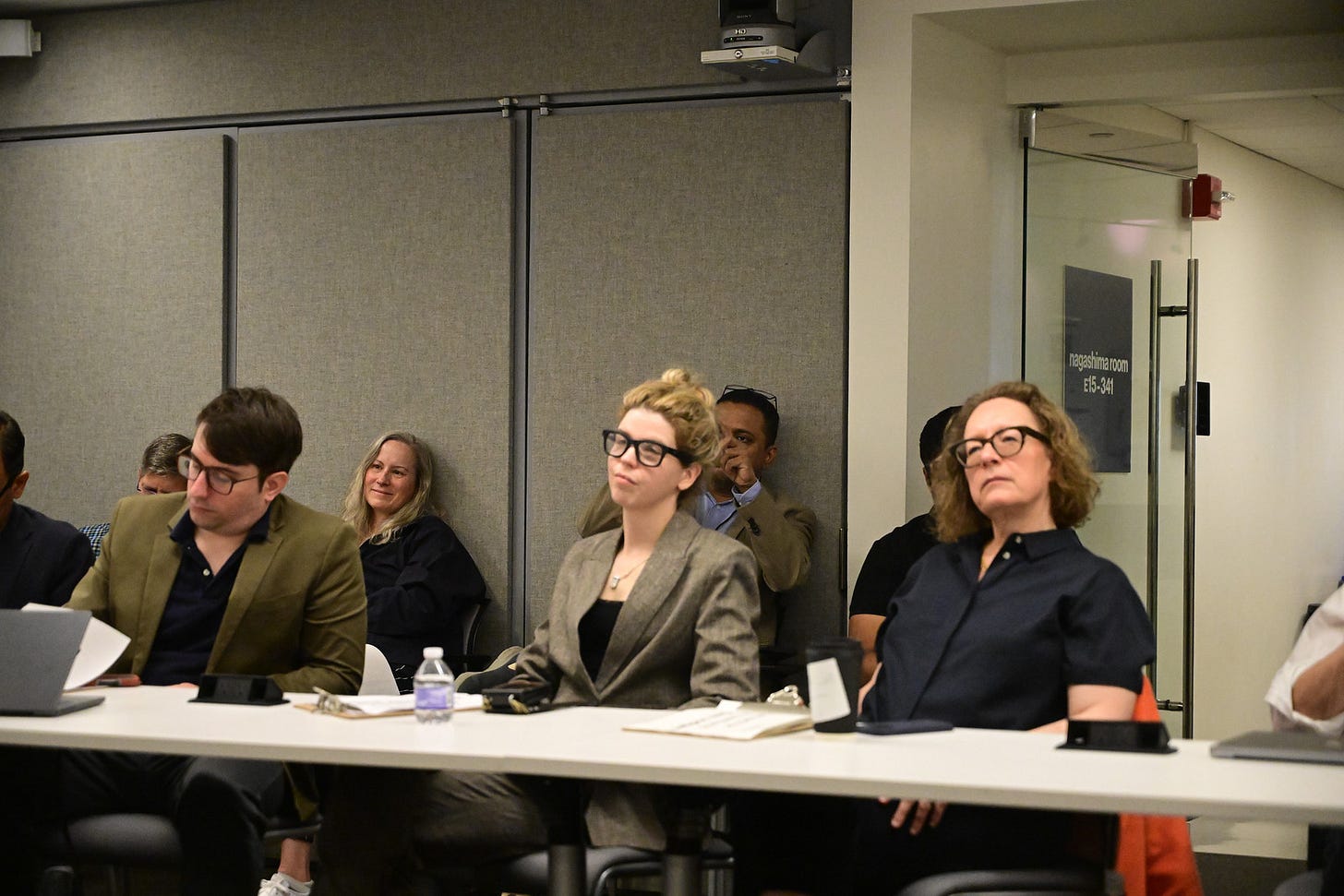
So that was very fun to be around. The event was lively. It was fast moving. There was not a sense of a lot of wasted time or speaking or attention. It was really great to be around.
And then finally oh yeah, one more thing about the first place group. They did everything that I've pointed out in red on the board or that I've repeated. they were very good about valuing time. They were very good about making. New points. Here's the point, here's the dependency. Let's follow up about this.
They're very good at visualizing and showing the thought and care that they put into stuff. It was evident. It wasn't wondering, nothing was sloppy and nothing was left—Everything that was shown was buttoned up and had its place and there wasn't a lot of excess.
(As in) the takeaway column explain their functioning. They very clearly communicated their expertise and showed that they were ready to build and showed that they were ready to be taken seriously. they did everything that I attempted to highlight in this review. They did a first class effort Which makes sense as they got first place. So good for them.
An era of uncertainty and opportunity
And then finally, just last, broad thoughts on, the frontiers ahead as I mentioned earlier is it the gold rush era for AgenticAI? Like we're already dealing with that with LLM stuff and then agentic AI and the agentic marketplace. Having agents that are gonna be interacting is a lot where many people are thinking about going. And a lot of these businesses were in that space, but even the vibe at the Media Lab and those folks (were) super interested in where that's going.
It is an unknown landscape though, like where nobody really knows outside of the…There was a strong lean towards the marketplace for now, but outside of that, there's a tremendous amount of who and what is going to be around and how is it going to shape. There's a lot of sense of, if you can plant the flag here, then maybe that will attract things there, but also uncertainty around it.
What will be available in five years? How fast will things take off? Is it the right time to go as far into AgenticAI as we can or is that a waste of time?
The sort of counter arguments to, all of the AI Agent stuff is. On one hand, you have all these reports saying, “the bottom rung of the job ladder is broken”. And there's both mid and high level, but all, especially for early career folks, it's a tough time to get experience there and AI is hitting that.
On the other hand, you're seeing reports saying for certain teams in certain areas of implementation, the AI-centered products are not really holding the weight. And they're appealing, but they don't actually carry through what needs to happen. It's a fun thing, and it's maybe a nice wrapper and you automate certain things, but the functional output itself isn't as good. So we're in this sort of dilemma of: what is the buy-in and what is the advantage of AgenticAI?
My kind of final perspective on this is, if you do a slight comparison to, what Meta is trying to do with their virtual reality workplace and bringing everything into the Quest headset and this virtual office and making all these parts of your life into the virtual, metaverse.
There's only so much buy-in even with the glasses and the visualizations and things that you can just do augmented reality with in the current world, it hasn't really taken off yet It is going to be interesting to see who is going to want to do the AI agents to the degree that we hope them to be.
So I think that's why the biggest question from the judges the audience and the catalyst was basically, who are you going to sell to and what is the market going to be? It's fair to say that it's a question that no one really knows the answer to. But with that said, MIT AI Ventures demo day was a huge…
MIT AI Ventures Demo day was definitely a interesting perspective and take on what can be done and who wants to really get involved with. Where these industries and opportunities can go.
So very thankful to have been a part of it. And if you were there, I would love to hear from you or talk more about it.
And in general I'm super interested in both of these events and the wisdom that we can take from them because I think the better products and the better AI approach we can have to various terms of innovation, especially, yes, the things that are about societal skill impacts that's a space I'm really trying to be in and facilitate good things in.
So if you have any questions or opportunities, partnerships or wisdom that you'd like to share in that space, let's talk about it, 'cause I think it matters a great deal.
That's all for today. Thanks so much for listening. This has been part of the new project from JOPRO, that's From Here to There: Mentoring and Strategy for Innovators — and hopefully much more like this ahead.
Thanks for your time. Bye-bye.

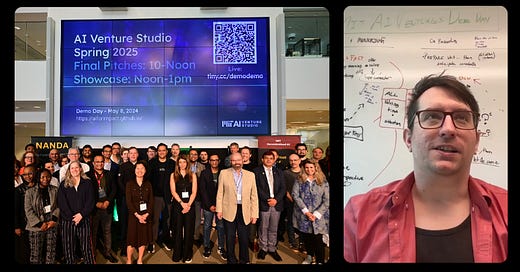




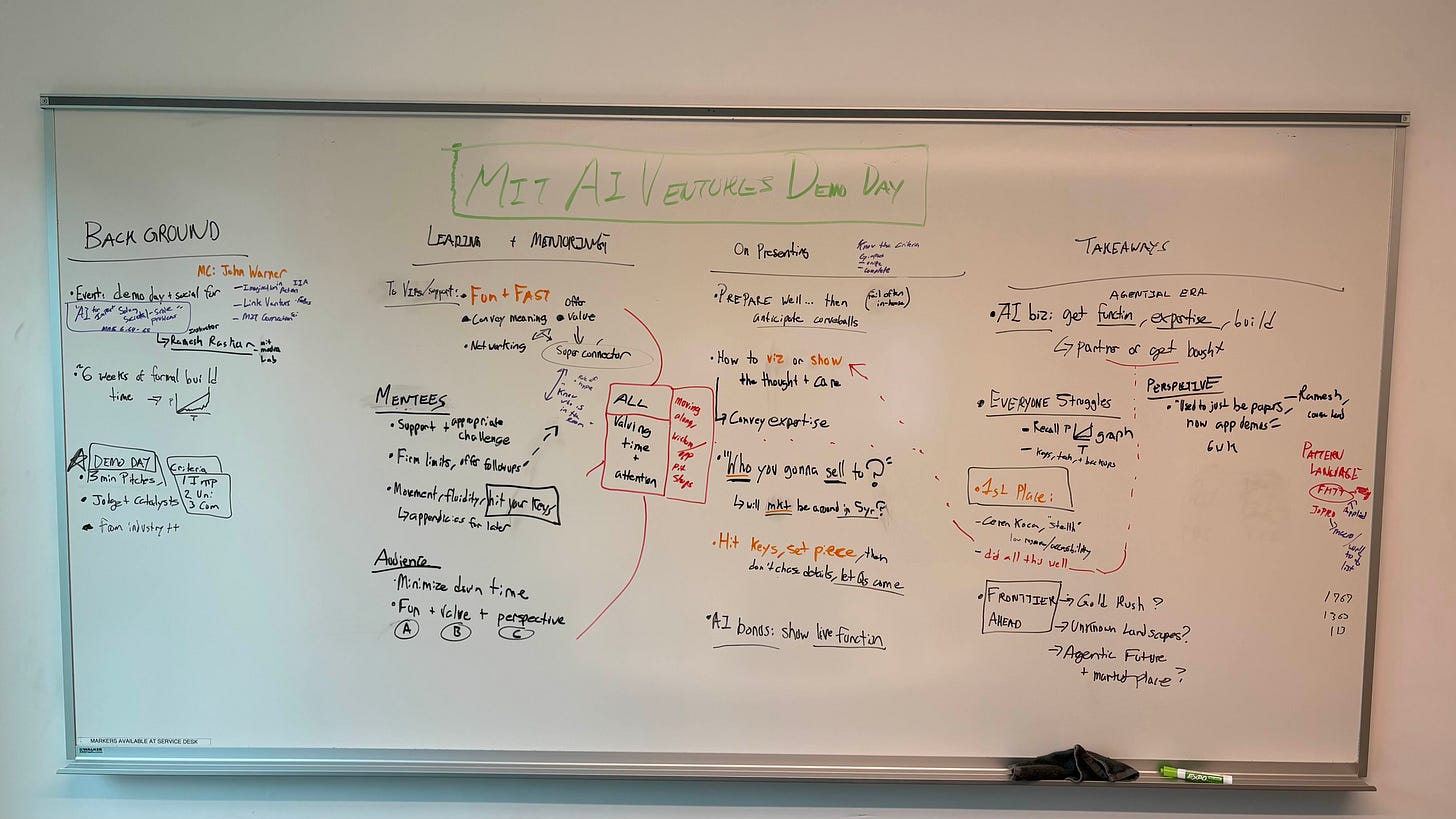

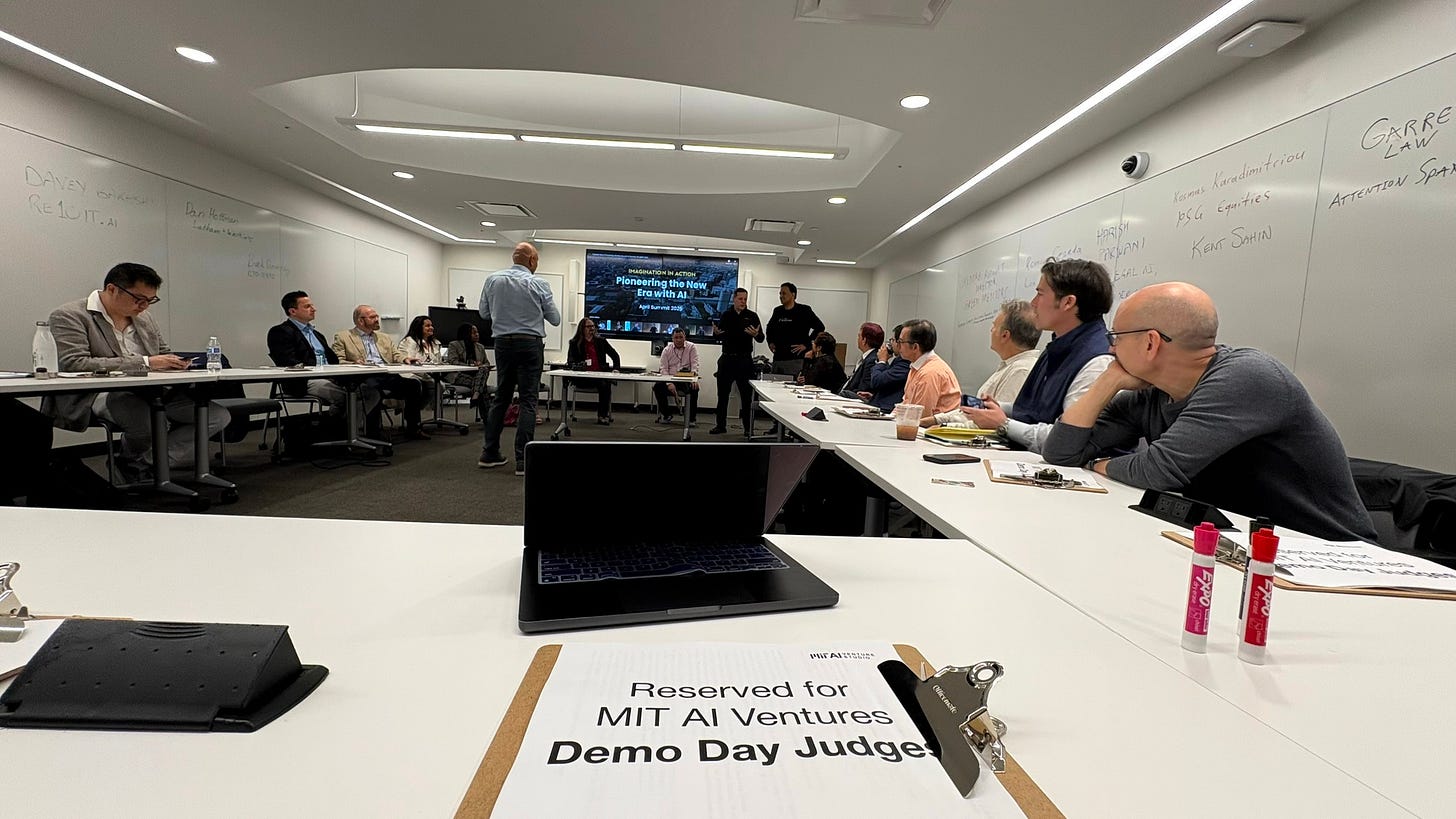

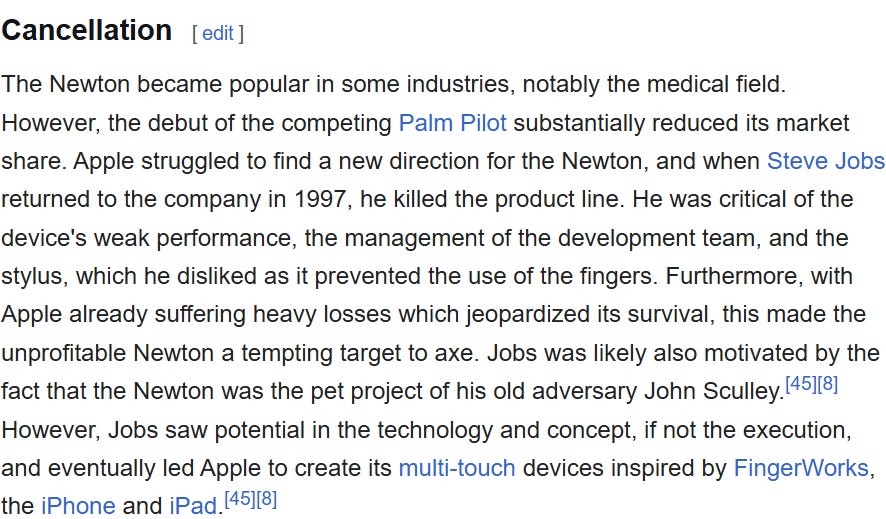
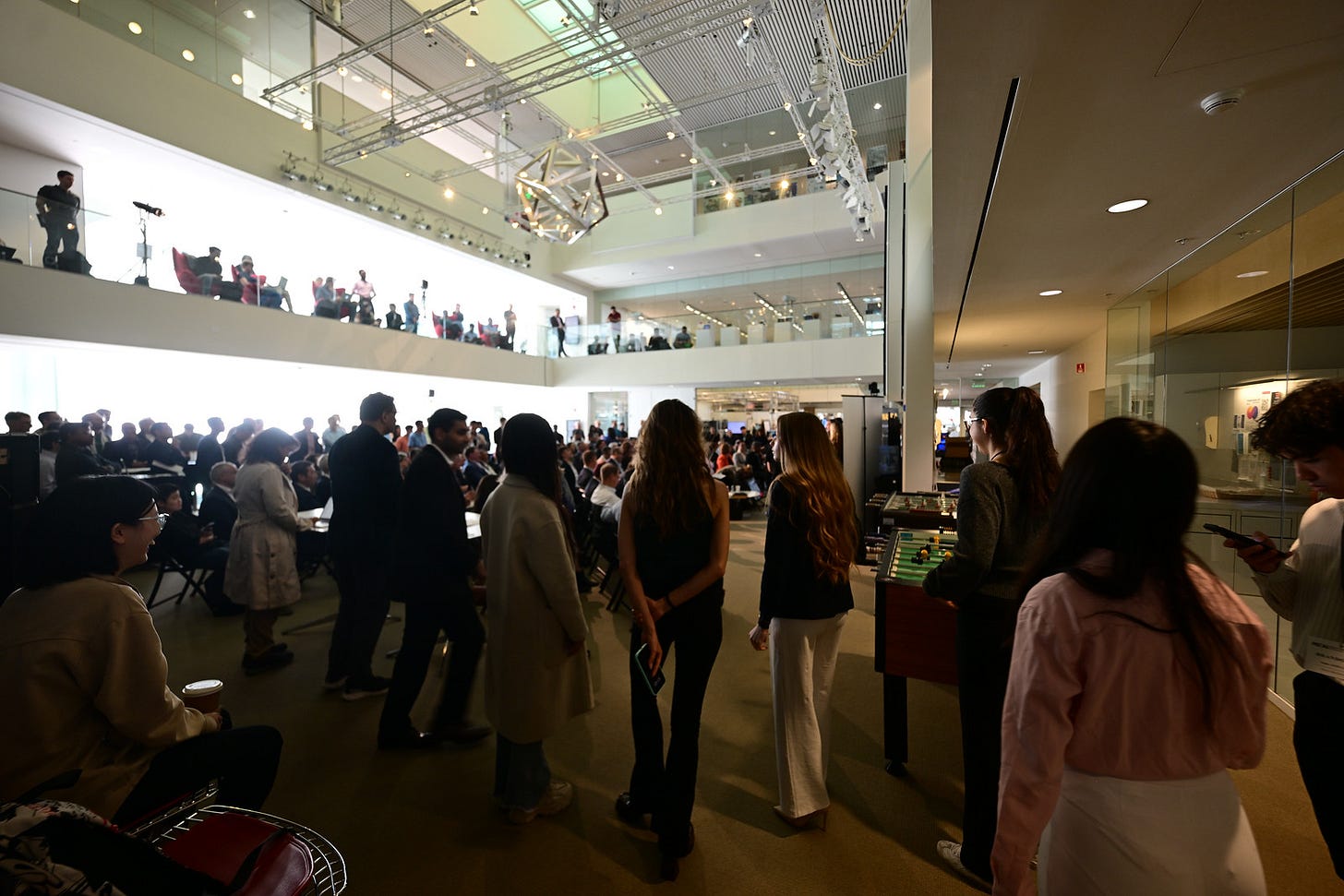
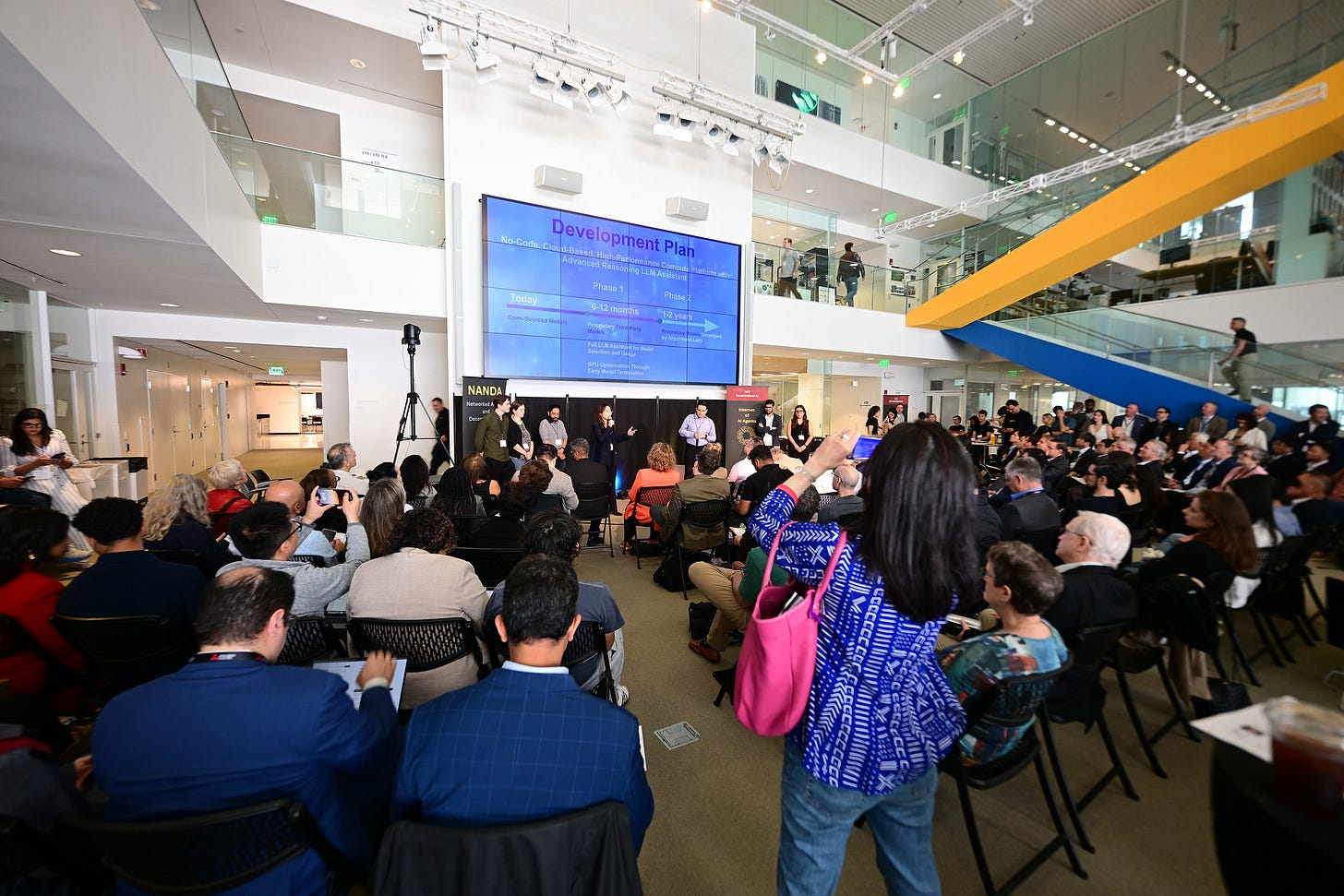
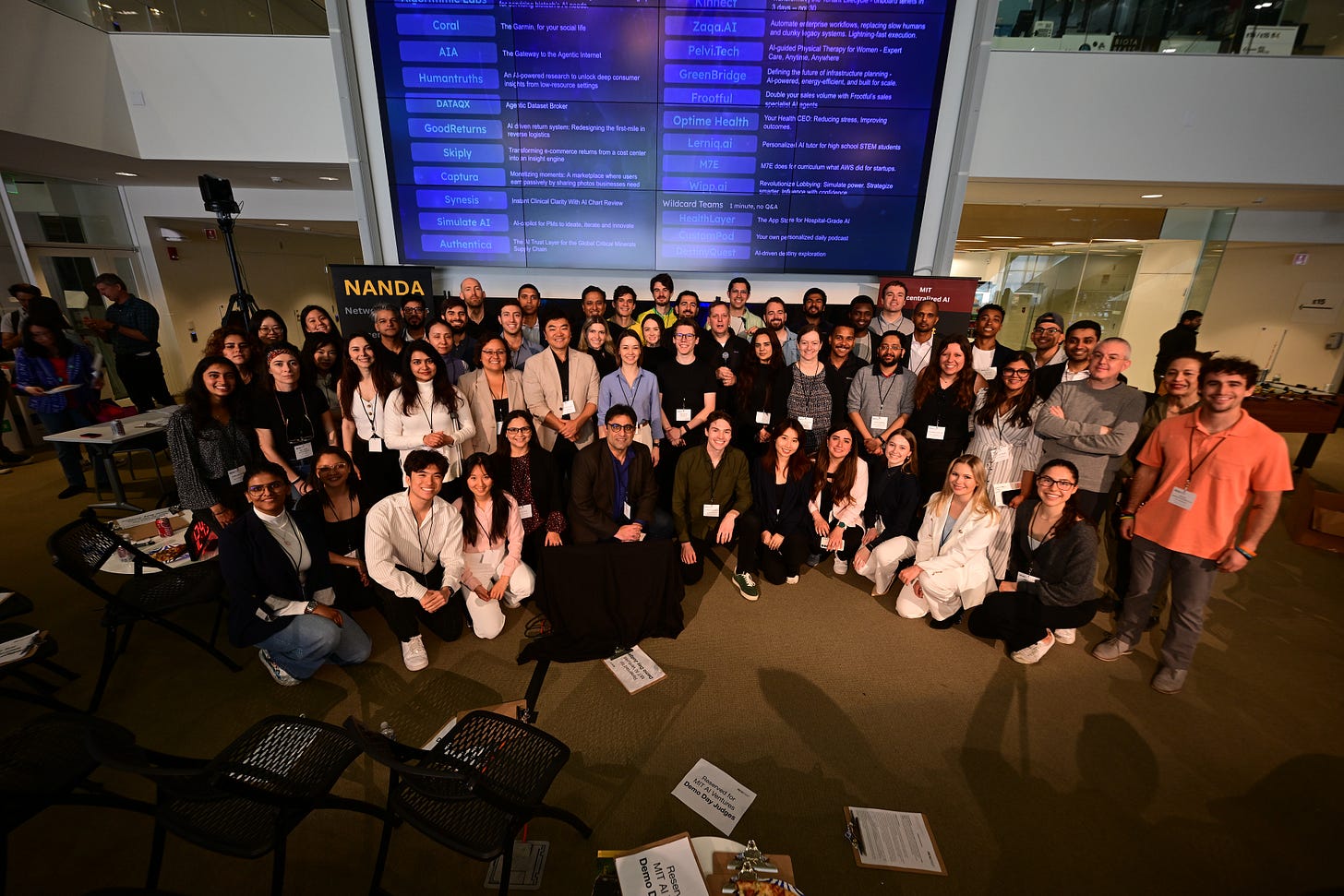






Share this post